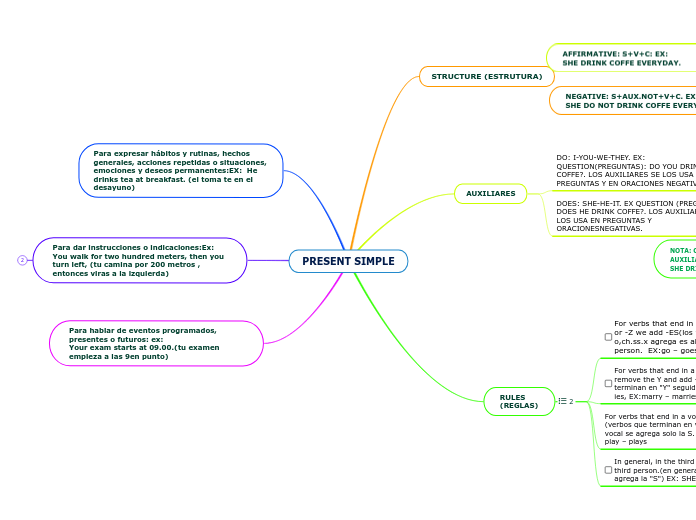PRESENT SIMPLE
Para expresar hábitos y rutinas, hechos generales, acciones repetidas o situaciones, emociones y deseos permanentes:EX: He drinks tea at breakfast. (el toma te en el desayuno)
Para dar instrucciones o indicaciones:Ex:
You walk for two hundred meters, then you turn left, (tu camina por 200 metros , entonces viras a la izquierda)
Para hablar de eventos programados, presentes o futuros: ex:
Your exam starts at 09.00.(tu examen empieza a las 9en punto)
STRUCTURE (ESTRUTURA)
AUXILIARES
DO: I-YOU-WE-THEY. EX: QUESTION(PREGUNTAS): DO YOU DRINK COFFE?. LOS AUXILIARES SE LOS USA EN PREGUNTAS Y EN ORACIONES NEGATIVAS.
DOES: SHE-HE-IT. EX QUESTION (PREGUNTA): DOES HE DRINK COFFE?. LOS AUXILIARES SE LOS USA EN PREGUNTAS Y ORACIONESNEGATIVAS.
RULES (REGLAS)
For verbs that end in -O, -CH, -SH, -SS, -X, or -Z we add -ES(los verbos que terminan en o,ch.ss.x agrega es al final), in the third person. EX:go – goes-catch – catches
For verbs that end in a consonant + Y, we remove the Y and add -IES. (los verbos que terminan en "Y" seguida consonante se cambia a ies, EX:marry – marries-study – studies
For verbs that end in a vowel + Y, we just add -S (verbos que terminan en vocal + "Y" seguida por vocal se agrega solo la S.
play – plays
In general, in the third person we add 'S' in the third person.(en general en tercera persona se agrega la "S") EX: SHE READS
